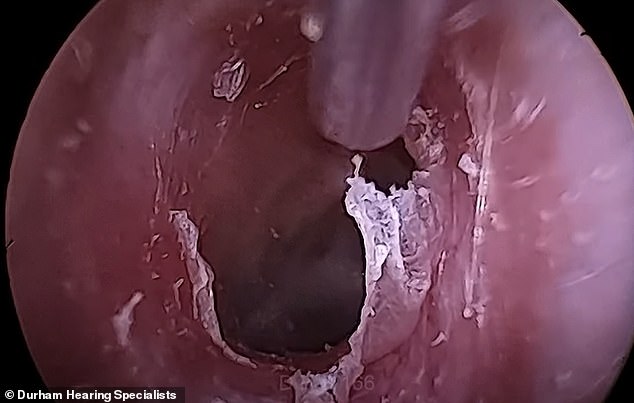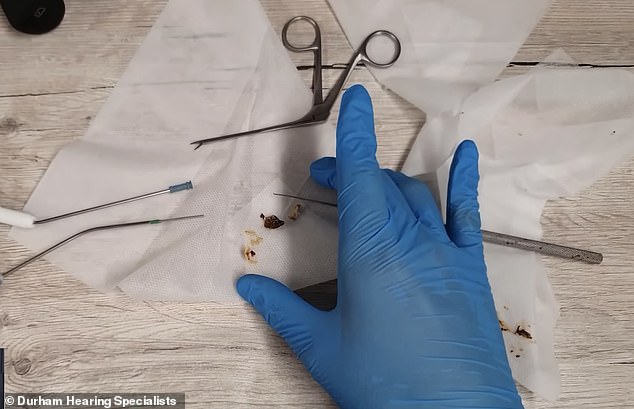Stomach-churning moment audiologist removes hardened wax from patient’s ear
An audiologist has shared a horrifying video on YouTube showing what happens when huge amounts of earwax build up in the ear canal.
The video, which is part of the Durham audiology practice’s YouTube channel series Hard as Nails, shows director of audiology, Mr Conor Boland, performing an endoscopic suction.
According to Mr. Boland, he wanted to upload this case because of the “tar gum dried molasses-like plug of wax in this ear, with natural mats and mats of hair, making it rather dense and strong.”
He added that he wanted to upload this case because “we get questions about water irrigation almost every day.”
According to the expert, people often wonder whether the process of water irrigation (formerly known as spraying) is safe.
The inside of the ear before it was cleaned. It is full of laundry which Mr Conor said takes some time to build up
He said: ‘We get a lot of questions about it. So hopefully in this video I’m going to show you and prove to you that water irrigation – in the right hands of course – is safe, appropriate and useful.’
At the beginning of the video he shows himself sucking the ear and explains that it is “useless at the moment.”
“So,” Mr. Boland explains, “what we’re going to do is…use warm water, heated to about 37 degrees Celsius.” He explains that water that is too hot or too cold can cause a feeling of dizziness.
The expert explains that the video is highly edited, because it took a very long time to clean it due to the enormous amount of wax.
“Again, you can see how much hair is matted with this wax,” he explains. “The patient, as you can imagine, has been putting this off for ages and ages and ages. You know, I’m almost positive he’s just being nice (he swallowed this with some kind of cotton swab).”
Remarkably, according to Conor, the process is not painful. ‘He just came to the clinic with a feeling of fullness in the ear and hearing loss that had existed for a long time.
“Again, it postponed it. So now we have to make some progress. And as you can see, the whole thing is moving now, which is a very good sign.”
At this point he mentions water irrigation again, as this was a key factor in cleaning the laundry.

After a long process, the ear was cleared of the large amounts of earwax and hair, leaving it looking very different from before the treatment

Some of Mr. Conor’s working tools, as well as some of the earwax recovered from the ear cleaning process
‘I think (with) perforation of the eardrum there is certainly a high chance of that happening if the irrigation is in the wrong hands.
“And the reason I say that is because you may have noticed during the video that the little plastic mouthpiece is usually angled so it’s pointing upwards.
‘So we actually direct that stream of water towards the roof of the ear canal. You can imagine that if an untrained person uses it, he’s going to point it at the eardrum like a gun…(so) there’s a good chance it’s probably going to perforate.”
Towards the end of the process, he says, “We’re not going to end up with a perfectly spotless canal. Actually, we don’t want that. There will always be bits of dead skin here and there.”
Only when the matte wax softened could he use tools to remove the mass from the eardrum.
Using a hook and a suction probe, he emptied the earwax from the ear, thus completing the process.
He explained, “But the most important thing is that we expose the eardrum that we’re looking for, which is kind of a blue-gray membrane in the background there. And there it is.
‘So the canal looks a bit sore, I have to admit. So what we’re going to do is send this patient to the pharmacist for severe sedation, which is diluted vinegar, and that’s going to prevent any infection and obviously calm all that irritation.
“So I mean, other than that, you know, a slightly red looking canal, everything looks pretty good, the eardrum looks beautiful. And now we just have to let this patient recover from the procedure.’
